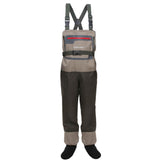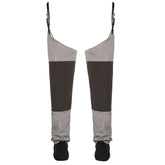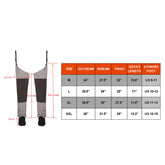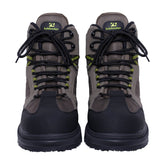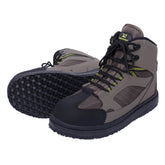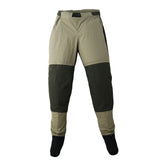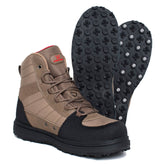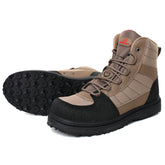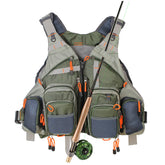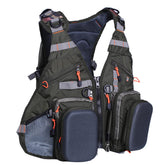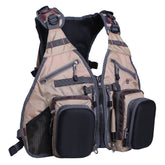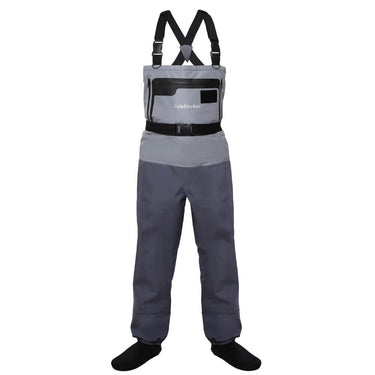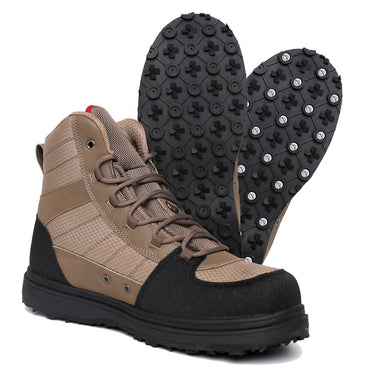What Do the Numbers on a Fly Rod Mean? (With Fly Rod Chart)
There are certain aspects of fly fishing that can get overwhelming. Learning the weights and numbers associated with a fly rod can be a bit challenging. Having a good understanding of these will allow you to fish your waters more efficiently. I had to spend a lot of time researching the various aspects of a fly rod before I was able to properly identify what I needed.
WHAT DO ALL THE NUMBERS MEAN ON FLY RODS?
The various numbers on a fly rod include the weight, length, action, and number of sections. The larger the number, the more flies and line it will allow you to use.

Numbers on a Fly Rod
WHICH FLY ROD WEIGHT SHOULD I GET?
Choosing the right weight for a fly rod can help you target the fish in an efficient manner. It will also allow you to make the most of your casting technique.
2-3 Weight Fly Rods
These days, the use of fly rods is a blast to be had, though they can only be fished in limited areas. With a couple of weight rods, you can easily cast delicate flies at small trout in water. At some point, you can also drop the fly a bit upstream and let it drift down behind the fish.
If you plan on spending a lot of time on skinny water, consider getting a fly rod. These will allow you to test your skills in casting and presentation. You won't be able to throw 40-foot casts with these types of rods, and your maximum distance will be around 25 to 30 feet.
4-6 Weight Fly Rods
The most common type of fly rod that a trout fisherman uses is the 4-6 weight. These are great for small to large rivers, and if you're in Montana, a 5- or 6-weight rod is ideal. With enough power to cast, you can still use delicate flies.
Most anglers choose to get a 4 to 6 weight rod for their first rig. This type of rod is versatile and can handle most freshwater fish. If you are already interested in learning more about the sport, then a 4-6 weight is ideal. You can use this type of rod without worrying about switching it.
You'll be able to cast 50 to 60 feet with a good quality line, and these rods are great for both still water and rivers. The versatility of these types of rods makes them ideal for different types of fishing.
7-8 Weight Fly Rods
The 7-8 weight is ideal for saltwater and freshwater fish, and if you're in Canada or Alaska, a 7 or 8-weight will do the trick when it comes to catching large freshwater and saltwater fish. These types of rods are also great for catching muskie, pike, and bass. Depending on where you're fishing, these will work just fine.
Although these types of rods are great for casting large poppers and streamers, they are not ideal for most types of fishing. If you are after smaller saltwater fish, then a 7 or 8-weight is ideal.
Casting through strong currents and large lakes will allow you to cast up to 70 feet with ease. If you're a fan of big fish, then this type of rod is worth the investment. This is a bit more expensive than other specialty rods, but it's still a great choice if you're after big fish.
9-10 Weight Rods
Most saltwater fishermen recommend using a 9 or 10-weight if you're after big fish such as salmon, sea bass, and stripers. Spey rods are also great for this type of fishing. If you live in areas where you frequently fish with large fish, a 9 or 10-weight is ideal.
Casting with a 9- or 10-weight rod will allow you to make long casts and fight double-digit fish without a problem. You'll most likely be using a variety of flies, such as streamer patterns, when you use this type of rod. When you're planning on fishing, you have to give it all you've got.
10 and Higher
When it comes to saltwater fishing, you need to use a lot of power to target large fish such as sea bass, tarpon, and sailfish. These types of fish are known to fight much harder than freshwater ones. You'll also need to be prepared to throw heavy flies and heavy leaders in order to catch them.
If you've never tried saltwater fly fishing, then take advantage of the opportunity to do so by hiring a guide. This will allow you to gain a deeper understanding of the sport and learn more about its various uses.
FLY ROD SELECTION CHART
To help other fly anglers choose a rod, I've created a chart that's free to download. You can look it over and download it right now.


FLY ROD ACTION
After choosing the right weight for your rod, it's time to choose the appropriate action. The right action depends on the type of fishing that you're doing and your experience.
Fast Action
One of the most popular types of fishing rods for experienced and strong-cast anglers is a fast action rod. This type of rod has the lowest amount of flex of any type of action, which allows it to perform well in windy conditions.
Medium-Fast Action
A medium or moderate fast action is versatile, and you can use it for a variety of techniques. You can also throw small flies, such as nymphs and dries, with ease using these types of rods.
Although a fast action rod won't allow you to completely cut through the wind, it will still perform well in windy conditions. If you're new to the sport of fly fishing, then try out a medium-fast action rod instead. This type of rod has a better sensitivity than others, and many experienced anglers still use it.
Medium Action
Although a medium-action rod is more forgiving than a fast action, it's not nearly as powerful. When using this type of rod, you have to be careful about the size of the fish that you're targeting. Also, since it has a bit more flex, you won't be able to fight bigger ones.
A medium action is also commonly used by cheap rod manufacturers to make lighter-weight fishing rods. This type of rod will allow you to lay down small dry flies easily.
Slow Action
Classic fly rods are known to be slow action. They're ideal for those who are looking to lay down small dry flies and fish small streams. If you're new to the sport of fly fishing, then a slow action rod might be a good choice.
Slow action rods won't allow you to feel that you're losing control of your line while you're casting. This type of rod is unsuitable for most situations, especially when you're planning on casting long distances.
FLY ROD LENGTH
Although the length of a fly rod can vary, it's important to consider the type of control that you'll have over your line when using it. For instance, if you're casting long distances, having a little bit farther to reach out may make a difference.
9-Foot Rods
A 9-foot fly rod is commonly used in both 5 and 6-weight categories. It's long enough to allow you to cast dry flies, but it can also launch long-distance streamers. A 5' 9-weight rod is versatile enough that you can use it in almost any situation.
8’ 6” Rod
Another popular length for both 5- and 6-weights is 8' 6”. While they won't provide as much action as other types of rods, these can still work well with nymphs and dries.
Rods Less than 8 Feet
If you're planning on fishing in small streams and rivers, then a rod that's less than 8 feet is ideal. If you know that you're going to be casting in skinny water, then a rod under 8 feet is the best choice.
Rods Longer than 9 Feet
Euro nymphing is a type of fishing that involves using long rods that are ultra-finesse rigs. These types of rods can be challenging to cast, but they allow for a longer reach and a more realistic presentation.
NUMBER OF SECTIONS IN A FLY ROD AND WHY
When the first fly rods were made, they were usually made in two pieces. Due to the advancements in technology, most fly rods are now made in four pieces.
One of the most important factors that you should consider when it comes to choosing a fly rod is the type of tube that it's made from. If you're planning on traveling with a two-piece rod, then you'll most likely have to pay for it.

7-Piece Fly Rod, Great for traveling
A lot of fly rods come in seven-piece variants, which are great if you're planning on traveling with a small amount of gear.
WHAT’S A GREAT ALL-AROUND FLY ROD?
An 8'6” all-around fly rod is versatile enough to be used on small lakes and rivers. If you're planning on using this type of rod, make sure that it has a moderate-action.
Although this type of rod provides sensitivity to lay-down dry flies, it's still long enough to cast long-distance flies. If you're planning on using this type of rod, then it's a good idea to own at least two of them.
WHAT DOES A 5/6 WEIGHT MEAN?
A 5/6-weight rod is commonly seen as one that can hold both 5- and 6-weight lines. If you're planning on purchasing one, make sure that you choose a rod that has a 6-weight line. This will allow you to get a better feel for the fly rod and make longer casts.
DO YOU NEED MORE THAN ONE FLY ROD?
The answer depends on how much fly fishing you're planning on doing. If you're planning on using a lot of fly fishing, then you'll need at least two rods. Doing so will allow you to fish all of the waters that you'll be visiting well.
If you're planning on using the same type of fly rod for multiple trips, then one might be a good choice. If you're like most fly anglers, then you'll probably end up getting into the habit of buying new rods.
LAST CAST WITH THE PERFECT WEIGHT FLY ROD
Choosing the right size fly rod can be an intimidating experience for new users. With a bit of research, you'll be able to determine the numbers that will work best for you. Having a well-balanced set will allow you to make better decisions when it comes to fishing.
Article refer:
1.What Do the Numbers on a Fly Rod Mean? (With Fly Rod Chart)
2.HOW TO SELECT A FLY FISHING ROD?
3.What equipment should be used for fly fishing for pike?
